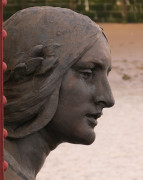

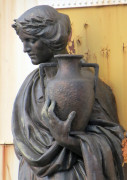
Vauxhall Bridge, and two of the allegorical statues.
Vauxhall Bridge, and two of the allegorical statues.


Vauxhall Bridge is of particular interest to these pages because of its excellent allegorical statuary by the New Sculptors Drury and Pomeroy. Anyone with Victorian art interests visiting London is bound to visit the Tate Britain, a couple of minutes walk away, and so has every reason to visit the bridge as well. Just up Vauxhall Bridge road is G. E. Street's St James the Less, in Gothic style with splendid polychrome interior and a mosaic by G. F. Watts. A short walk upstream can be made to see a statue by John Gibson. South of the river can be a bit grim, but a walk can be made through to Lambeth Bridge and thence along the Albert Embankment through to Westminster Bridge.
The bridge itself was built in 1895-1906 by Alexander Binnie, reusing footings of the previous bridge, which dated from 1816. The statue has 5 arches, and the statues we have come to see are on the piers (pillars) between each arch. Most annoyingly, there is nowhere where one can get a really good view of them except from a boat. Peering over the edge of the bridge gives us a view from just above each statue, very obliquely, so we can see a profile, a breast, what she carries in each hand, and looking almost straight down, an open-toed sandal, but not the statue as a whole. From the riverside on the north or south bank, we can at least see the closest statues in 3/4 view, or close to it, but even the second statue away from each side is too far to make out much detail without some visual aid. Having said all that, it is still certainly worth seeing them. It makes an odd story though: the bridge was built well under the expected budget (imagine that today), and the spare money was used to commission eight of the largest bronze statues in London. These were then emplaced so that they could not be easily seen. And a hundred or so years later they still stand there, entirely unknown to 99% of the people walking over the bridge.
So, here we give pictures of all eight of the Vauxhall Bridge statues, two views each taken from each bank of the river, as an appreciation of these excellent works from the zenith of Edwardian allegorical sculpture, by the best of sculptors working in the New Sculpture, rather arts and crafts in style. As ever, you will need to click on the small pictures to see them properly.
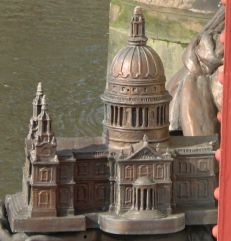
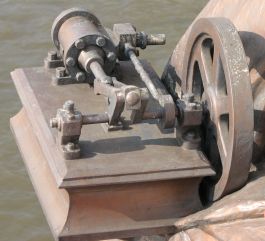 Details of Architecture and Engineering, by Pomeroy, upstream.
Details of Architecture and Engineering, by Pomeroy, upstream.
On the upstream side, F. W. Pomeroy was the sculptor. From the south-east side, the first allegorical figure is Pottery; second is Engineering;third is Architecture; and finally, closest to the north-west bank is Agriculture. We consider them in turn.

 Statue of Pottery, by Pomeroy.
Statue of Pottery, by Pomeroy.
We start with the allegorical statue of Pottery, then. She carries a pot, of course, a large, heavy Classical one cradled against her shoulder; her other hand is on her hip, sleeve pulled up to show a brawny arm. Her neck, too, is that of an Amazon, and we can imagine her as the artist who made the pot, her body strengthened by years of kneading clay. As with all the statues, she is dressed in Classical robes, Hellenistic rather than Hellenic in style. Her face and hair, though, are Edwardian Arts and Crafts.

 Pomeroy's statue of Engineering.
Pomeroy's statue of Engineering.
For the statue of Engineering, Pomeroy has chosen the standard accoutrements of a hammer and anvil, seen in the view from the left side, and she also holds a small steam engine, a fixed beam engine with a single large wheel and piston. Again, her arm is muscular, and she is rather more mature than Pottery, with a rather careworn face. Her cloak makes a satisfying sweep around her upper body, being gathered over her crooked arm in Roman fashion.
The statue of Architecture is youthful and beautiful. She holds in one hand a pair of compasses, and in the other, a little sculpture of St Paul's Cathedral: the scale of the statue is indicated by this model being some 2 ft long. She is also seen to be standing with one foot on an Ionic capital. The view from the right shows the slender curves of her figure to advantage.
The allegorical figure of Agriculture carries a tall scythe, and has her other arm holding a large sheaf of corn, excellently and naturalistically rendered. She combines the Classical drapes of her sisters with a half-unbuttoned shirt so naturally that we do not notice any discrepancy, and her hood has something of a nod to the statues of agricultural labourers of Hamo Thornycroft.
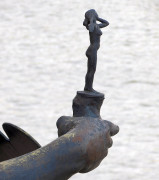
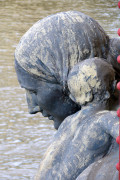 Detail's of Alfred Drury's statues of the Fine Arts and Education, downstream.
Detail's of Alfred Drury's statues of the Fine Arts and Education, downstream.
The Vauxhall Bridge statues on the downstream side are by the sculptor Alfred Drury, a personal favorite of mine. His subjects are Education, Fine Art, Science, and Local Government.
The statue of Education has a mother with two children; a boy standing in front of her, sheltered under her cloak, holding a book, and a naked infant on her shoulder. Thus we have a sense of protection and nurturing as part of education in its widest sense. More statues of Education are on this page.
Alfred Drury's statue of the Fine Arts is of course the best of his statues on Vauxhall Bridge. She carries a palette and brushes, and holds to her breast a small leafy branch bearing some fruit, evocative of natural beauty and imagination. In her other hand she holds a small nude statue, representative of Sculpture. Her face is very characteristic of one of Drury's preferred female ideals. The drapery is finely conceived, with repeating concentric folds around the arms for a harmonious composition.
The allegorical statue of Science, rather more slender of build than the other statues, carries an astronomical globe as her only accoutrement. She is dressed in a long robe with severe, rather symmetrical folds hanging down to the ground, increasing the sense of gravity and serious pursuits.
This is the only allegorical statue of Local Government I have come across in London, though there are examples of keystone heads depicting this subject. A rather stern-visaged figure, she holds in one hand a book of Law, her other hand pointing directively in a gesture of command.
(For other examples of allegorical statues, see the Allegorical Alphabet.)
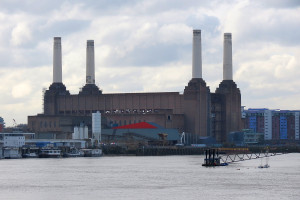 Battersea Power Station from Vauxhall Bridge.
Battersea Power Station from Vauxhall Bridge.
So far as the view goes, the Thames swings round at this point from an east-west course upstream to a northerly direction, with the bridge just at the bend. So the view upstream is very different from that from Lambeth Bridge, which has an upriver view almost due south. Here, the view is dominated by the huge Battersea Power station, a gasometer, and modern things. Downstream, the London Eye dominates, and there is an oblique view of the Houses of Parliament from the south end (see bottom of page). On the north-west bank, the dome of the old Tate (Tate Britain) can be seen. The tall spire which can be seen on the north side is that of St Saviour Church, by the architect Thomas Cundy, which stands at one end of St George's Square, see bottom of this page.
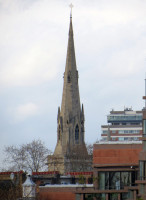 Spire of St Saviour, by Thomas Cundy, 1860s.
Spire of St Saviour, by Thomas Cundy, 1860s.
Vauxhall Bridge Road was at one time a haunt of potters and architectural sculptors. (There actually exists a pottery showroom just off to one side of the road, though whether this is a recent addition or represents some genuine continuity with the former potters I don't know.) J. Birnie Philip had his architectural sculpture practice here, as did a certain Peter Wright who carved the various small heads and leafy bits in Caen stone for St Stephens, Rochester Row nearby. Just south of the river was the Grosvenor Life School, run by a certain Mr Donne, and here the architect J. L. Pearson had his first major commissions (Holy Trinity Church, then St Peter's Church and Art Schools in Kennington Lane).
Further artistic interest is earlier still. The 1816 bridge, by James Walker, was originally known as the Regent Bridge, but took its present name from the proximity to Vauxhall Gardens, themselves of some artistic note. Originally called the New Spring Garden in the 17th Century, Vauxhall Gardens were done up considerably by a certain Jonathan Tyers in the 1730s, with musical entertainments through the summer, decorated gardens with paintings by Hogarth (then a friend of Tyers), and a fine statue of Handel, the work of Roubiliac, of which a later description writes that 'the eminent composer in the act of rapturous meditation when the music had fully awakened up his soul... Though every button of his dress seems to have sat for its likeness, and every button hole is finished with the fastidiousness of a fashionable tailor, the clothes are infected with the agitation of the man, and are in staring disorder.' That statue at least did not remain long at Vauxhall. It went at one time to the house of Mr Barrett of Stockwell, and then to a house in Dean St, and eventually found its way to the Victoria and Albert Museum.
After various ups and downs, including being at one time the haunt of prostitutes, later Vauxhall Gardens went sharply upmarket, with an entrance fee, and by about 1850 had some Gothic roofed structure with an orchestra and casts from the antique - the statues included Eve after the Bath, Diana, copies of Canova's dancing girls, and nearby a fountain with a Neptune complete with trident, 'driving 5 seahorses abreast ,which are snorting forth liquid streams from their nostrils'. An Italian walk had further statues, and a line of colonnades had 'supper boxes' with paintings by Francis Hayman (1708-1776) and his pupils. Later in the 1850s, the Gardens fell out of fashion again, shut down, and eventually everything was sold off by auction, including statues and paintings often at knockdown prices - 'a large historical painting of the King of Sardinia with the order of the garter, being introduced by Prince Albert to the Queen - 35 shillings; an equestrian picture of the Emperor and Empress of the French at a hunting party, 22 shillings;' and so forth. From here, on the north west bank, walking downstream leads to Tate Britain with its Victorian collections. Straight up Vauxhall Bridge Road for 5 minutes allows a visit (around lunchtimes only) to St James the Less off on the left hand side, and proceeding further leads to Victoria Station and Westminster Cathedral. A walk upstream on that side goes to the modest Pimlico Gardens, with a stone statue of William Huskisson by John Gibson, and from where striking inland passes some of the more ornate housing of the Pimlico area. On the south side, a walk into town goes via Lambeth and then Westminster Bridge, and leads into town, with many good views. Or walking south-west, past the Oval leads to the Waterloo church of St Mark's, Kennington. Or go along the Albert Embankment to the Doulton factory on Black Prince Road or Albert Embankment Gardens).
Sculpture in London // Sculpture pages
Visits to this page from 23 Nov 2011: 10,259 since 3 October 2022